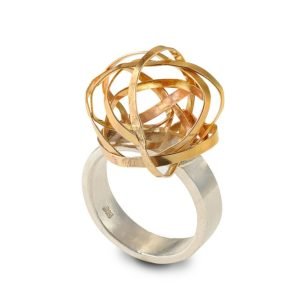I am pleased to bring to you a guest post by Jinisha Shah and Sanjana Kochhar, Associates at Solomon & Co. on the protection of a jewellery design under the framework of various intellectual property laws in India.
Solomon & Co. is a century old multi-service law firm with offices in Mumbai and Pune. The firm regularly advises intellectual property, media and entertainment clients.
Jinisha Shah is an Associate in the Intellectual Property Rights Team at Solomon & Co. She is a registered Patent and Trademark Attorney with over 8 years of experience in this field. She holds a Master’s degree in Law with a specialization in Intellectual Property as well as a Master’s degree in Science with a specialization in Microbiology. She possesses substantial experience and expertise in the prosecution of patents, designs, trademarks and copyrights.
Sanjana Kochhar is an Associate at Solomon & Co. and registered as an Advocate with the Bar Council of Maharashtra and Goa. Sanjana holds a B.S.L. LL.B degree as well as a diploma in Human Rights from I.L.S. Law College, Pune. She has worked extensively on a wide range of corporate and intellectual property matters over the years.

“JEWELLERY DESIGN” – AN INTELLECTUAL PROPERTY ASSET
Jinisha Shah & Sanjana Kochhar
In the past decade demand for fashion jewellery has boomed in India. The jewellery sector is influenced by seasonal fashion, consumer trends and e-commerce platforms. Thus, there is an augmented demand to showcase fashion jewellery on various platforms and several jewellery artists are gaining tremendous visibility and popularity. This growing demand of fashion jewellery has led to increase in substantial similarity in the designs showcased. In other words, jewellery designs are easily replicated, lifted or copied to be visible, available and to gain popularity. Therefore, there is an increasing need to protect this valuable asset due to the growing demand. However, a key question that arises is “How could one protect an original jewellery design?”
Intellectual Property Laws lay down safeguards for its protection. Jewellery design can be protected under various Intellectual Property laws such as Copyright, Designs, Patents and Trademarks. Now, the immediate question that arises is “which aspect of jewellery design is protected under what Intellectual Property law?”
While the brand name and logo of the jewellery or the jewellery line are usually registered under Trademark law, the original design of a jewellery article can be protected under the framework of the Copyright law or under Design law. Further, in the event a unique technology is involved in obtaining the design of jewellery; the same can be protected by applying for a patent.
In this article, we shall deal with the protection of jewellery design under Copyright Act, 1957 and Designs Act, 2000. While evaluating the protection of jewellery design under the Copyright Act vis-à-vis the Designs Act, the concepts of “design” and “copyright” need to be examined thoroughly. It is also imperative to gauge the difference between the rights that accrue under each Act.
“Design” has been defined under Section 2 (d) of the Designs Act, 2000. A design bears reference to the features of shape, configuration, pattern, ornament or composition of lines or colours applied to any article in two dimensional or three dimensional or in both forms by any industrial process or means, whether manual, mechanical or chemical, separate or combined which in the finished article appeal to and are judged solely by the eye.
Significant requirements for an original design to be eligible for registration under the Designs Act, 2000 are:
- The design must be new or original;
- The design should not have been disclosed to the public anywhere in India or in any other country by publication in tangible form or by use or in any other way prior to the filing of the design for registration;
- The design should be significantly distinguishable from known designs or combination of known design; and
- The design shall not comprise or contain scandalous or obscene matter.
“Copyright” means the exclusive right (subject to the provisions of the Copyright Act), to do or authorise the doing of any of the acts specified under Section 14 of the Copyright Act, 1957 and includes amongst other acts, reproduction of an artistic work in any material form including depiction in three dimensions of a two-dimensional work or in two dimensions of a three-dimensional work.
The distinction between a design, an artistic work and a copyright in a design has been laid down by Justice S. C. Gupte of the Hon’ble High Court of Bombay, while deciding the case of Pranda Jewellery Pvt. Ltd. & Ors versus Aarya 24K (2015).
The Court held that ‘artistic work’ so long as it can qualify as an artistic work reproduced in any form shall continue to enjoy the copyright available to it under the Copyright Act, 1957. But when it is used as the basis for designing an article by its application by an industrial process or means, meaning thereby an article other than the artistic work itself in a two or three dimensional form, it would enjoy a lesser period of protection of copyright under Section 11 of the Designs Act, 2000, if registered as a design under that Act, and if not so registered (despite being registrable), would cease to enjoy any copyright after more than fifty such applications, under Section 15(2) of the Copyright Act, 1957. Once again, as an original artistic work it would continue to enjoy the full copyright under the Copyright Act, 1957 and cannot be reproduced in any two or three-dimensional form by anyone except the owner of the copyright. What it would cease to enjoy is the copyright protection in its industrial application for production of an article. … In practice, it works like this. If a painting, say Hussain’s painting of a horse, is simply reproduced in any medium, i.e. on paper, canvass or even a cloth, and in any form, i.e. in two or three dimensions, whether by an industrial process or otherwise, it will continue to enjoy full copyright in such reproduction under the Copyright Act. But if the painting is used as a motif to produce, say, sarees, the industrial application, namely, use as a motif in a saree, would lose copyright protection, if not registered as a design under the Designs Act, 2000, after more than fifty applications. The difference between the former use and the latter use is that what is reproduced is an artistic work itself in the former and what is produced in the latter case is an article, which is not by itself an artistic work.
Applying this principle to the present article, what we can infer is that what is produced by the artist with the use of the artistic work contained in the original drawing is a reproduction in a material, namely, in gold or metal plates in a form being either two or three dimensional. Thus, what is produced is the artistic work itself and accordingly such work ought to enjoy a full protection under the Copyright Act, 1957.
On the other hand, features of shape, configuration, pattern, ornament or composition of lines or colours applied to the jewellery in two dimensional or three dimensional or in both forms either by any industrial process or manually could render the design registrable under the Designs Act, 2000.
In view of the above, it could be inferred that original work in any form, be it artistic works or designs could be registered and protected under the Copyright Act, 1957 or the Designs Act, 2000. The applicant (i.e. the jewellery designer) must therefore consider the following aspects prior to publishing or marketing its designs:
- Business model – the number of articles to be manufactured and/ or sold;
- Publication – must be made only in the event the applicant does not wish to register the jewellery under the Designs Act.
Thus, it is concluded that a jewellery design can be registered either under The Design Act, 2000 or The Copyright Act, 1957 and that there can be no co-existence in terms of registration under both Acts.
Image Source: Here


















